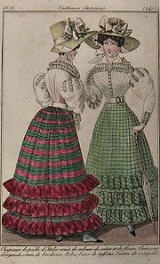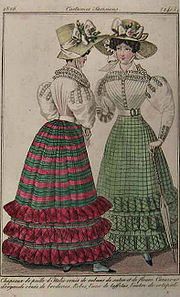
Tartanry
Encyclopedia

Kitsch
Kitsch is a form of art that is considered an inferior, tasteless copy of an extant style of art or a worthless imitation of art of recognized value. The concept is associated with the deliberate use of elements that may be thought of as cultural icons while making cheap mass-produced objects that...
elements of Scottish culture that have been over-emphasized or super-imposed on the country first by the emergent Scottish tourist industry in the 18th and 19th centuries, and later by an American film industry. The earliest use of the word "tartanry" itself is said to have been in 1976.
Tartanry refers to often mispresented or invented aspects of Scotland
Scotland
Scotland is a country that is part of the United Kingdom. Occupying the northern third of the island of Great Britain, it shares a border with England to the south and is bounded by the North Sea to the east, the Atlantic Ocean to the north and west, and the North Channel and Irish Sea to the...
such as clan
Scottish clan
Scottish clans , give a sense of identity and shared descent to people in Scotland and to their relations throughout the world, with a formal structure of Clan Chiefs recognised by the court of the Lord Lyon, King of Arms which acts as an authority concerning matters of heraldry and Coat of Arms...
tartan
Tartan
Tartan is a pattern consisting of criss-crossed horizontal and vertical bands in multiple colours. Tartans originated in woven wool, but now they are made in many other materials. Tartan is particularly associated with Scotland. Scottish kilts almost always have tartan patterns...
s, kilt
Kilt
The kilt is a knee-length garment with pleats at the rear, originating in the traditional dress of men and boys in the Scottish Highlands of the 16th century. Since the 19th century it has become associated with the wider culture of Scotland in general, or with Celtic heritage even more broadly...
s, bagpipes, Scottish Gaelic and Highland
Scottish Highlands
The Highlands is an historic region of Scotland. The area is sometimes referred to as the "Scottish Highlands". It was culturally distinguishable from the Lowlands from the later Middle Ages into the modern period, when Lowland Scots replaced Scottish Gaelic throughout most of the Lowlands...
culture more generally.
The repeal of the Dress Act
Dress Act 1746
The Dress Act was part of the Act of Proscription which came into force on 1 August 1746 and made wearing "the Highland Dress" including tartan or a kilt illegal in Scotland as well as reiterating the Disarming Act...
in 1782 saw a romantic revival of tartan, kilts, bagpipes and Highland traditions, both genuine and imagined, which in time became seen as Scottish traditions, famously celebrated during the visit of King George IV to Scotland
Visit of King George IV to Scotland
The 1822 visit of King George IV to Scotland was the first visit of a reigning monarch to Scotland since 1650. Government ministers had pressed the King to bring forward a proposed visit to Scotland, to divert him from diplomatic intrigue at the Congress of Verona.The visit increased his popularity...
in 1822. Lord Macauley
Thomas Babington Macaulay, 1st Baron Macaulay
Thomas Babington Macaulay, 1st Baron Macaulay PC was a British poet, historian and Whig politician. He wrote extensively as an essayist and reviewer, and on British history...
wrote of the displays on that occasion that:
The last British king who held court at Holyrood thought that he could not give a more striking proof of his respect for the usages which had prevailed in Scotland before the Union, than by disguising himself in what, before the Union, was considered by nine Scotchmen out of ten as the dress of a thief.
See also
- Scottish national identityScottish national identityScottish national identity is a term referring to the sense of national identity and common culture of Scottish people and is shared by a considerable majority of the people of Scotland....
- Visit of King George IV to ScotlandVisit of King George IV to ScotlandThe 1822 visit of King George IV to Scotland was the first visit of a reigning monarch to Scotland since 1650. Government ministers had pressed the King to bring forward a proposed visit to Scotland, to divert him from diplomatic intrigue at the Congress of Verona.The visit increased his popularity...
- BrigadoonBrigadoonBrigadoon is a musical with a book and lyrics by Alan Jay Lerner and music by Frederick Loewe. Songs from the musical, such as "Almost Like Being in Love" have become standards....
- White Heather ClubWhite Heather ClubThe White Heather Club was a BBC TV Scottish variety show that ran on and off from 7 May 1958 to 1968.It was an early evening BBC television programme. Until 1957 there was a silent period in BBC TV broadcasting, between 6pm and 7pm, called the Toddlers' Truce. When this ended, the BBC was unsure...

